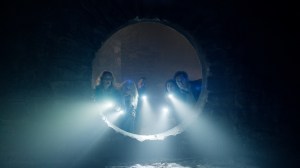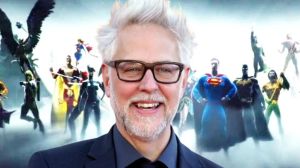Rogue One: A Star Wars Story is in theaters now, and while fans argue about who the best new character is, or what K-2SO’s funniest line was, they can almost all agree that Darth Vader was a particular standout in the film. While many of those conversations talk about his third appearance in the movie, we want to take it back to his first.
Videos by ComicBook.com
SPOILERS ON for Rogue One: A Star Wars Story!
When we first see Darth Vader, we meet him on a firy, lava-filled planet. According to the Star Wars Story Group’s Pablo Hidalgo, yes, that’s the same planet we saw a younger Darth Vader on in Star Wars: Episode III – Revenge of the Sith, Mustafar. That information was confirmed in the art book for the film, alongside concept art of Vader and Krennic meeting on Mustafar.

The burning planet was the site of Vader’s true rebirth, after being christened by Palpatine, aka Darth Sidious in his office. Vader went to Mustafar for his final confrontation with his former master, Obi-Wan Kenobi, and it didn’t go too well for the new Sith Lord. He lost his limbs (literally, all of them), and was horribly burned in the lakes of flame.
So why would Darth Vader be not just on Mustafar, but seemingly living there? For that we look to the Darth Vader comic book from Marvel Comics. In that canon series, launched in January 2015, the first thing The Emperor does after Darth Vader’s failure to protect the Death Star in Star Wars: Episode IV – A New Hope is sends him to a place he knows will cause him pain. A return to Tatooine serves the Emperor and his mission, sure, but it also serves to fuel Darth Vader. The idea is that if Vader goes to Tatooine, where he was a slave, where his mother died, where he first cut loose with rage, he’ll be able to harness all of that into dark side power. As a pleasant side effect for the Emperor, it also causes him genuine pain, keeping the Sith apprentice in check.

Mustafar has the same effect – it’s not just a source of dark side energy, but it’s the literal source of all of Darth Vader’s pain and hatred, as far as he’s concerned. He doesn’t see that he was manipulated – he just thinks he was betrayed. Vader genuinely feels that he was the one wronged by Obi-Wan Kenobi and the Jedi order, not that he turned against them, and Mustafar serves as a constant reminder. One piece of concept art for Rogue One shows Vader meditating in the literal fires of Mustafar, a chilling scene that wasn’t in the film but still serves to demonstrate how he used that place, and its memories to fuel his power.
Perhaps that’s why Darth Vader was able to cut loose the way he did at the end of Rogue One, in comparison to his relatively low power level in A New Hope, but that’s a question for another day.
MORE STAR WARS NEWS: Rogue One: A Star Wars Story Five Best Moments | How The Force Changed in Rogue One: A Star Wars Story | Cut Footage From Original Star Wars Used In Rogue One | Rogue One Scores One Of The Biggest Opening Box Office Weekends Ever | Who are the Characters in Rogue One: A Star Wars Story? | Why Darth Vader’s Costume Changed for Rogue One








